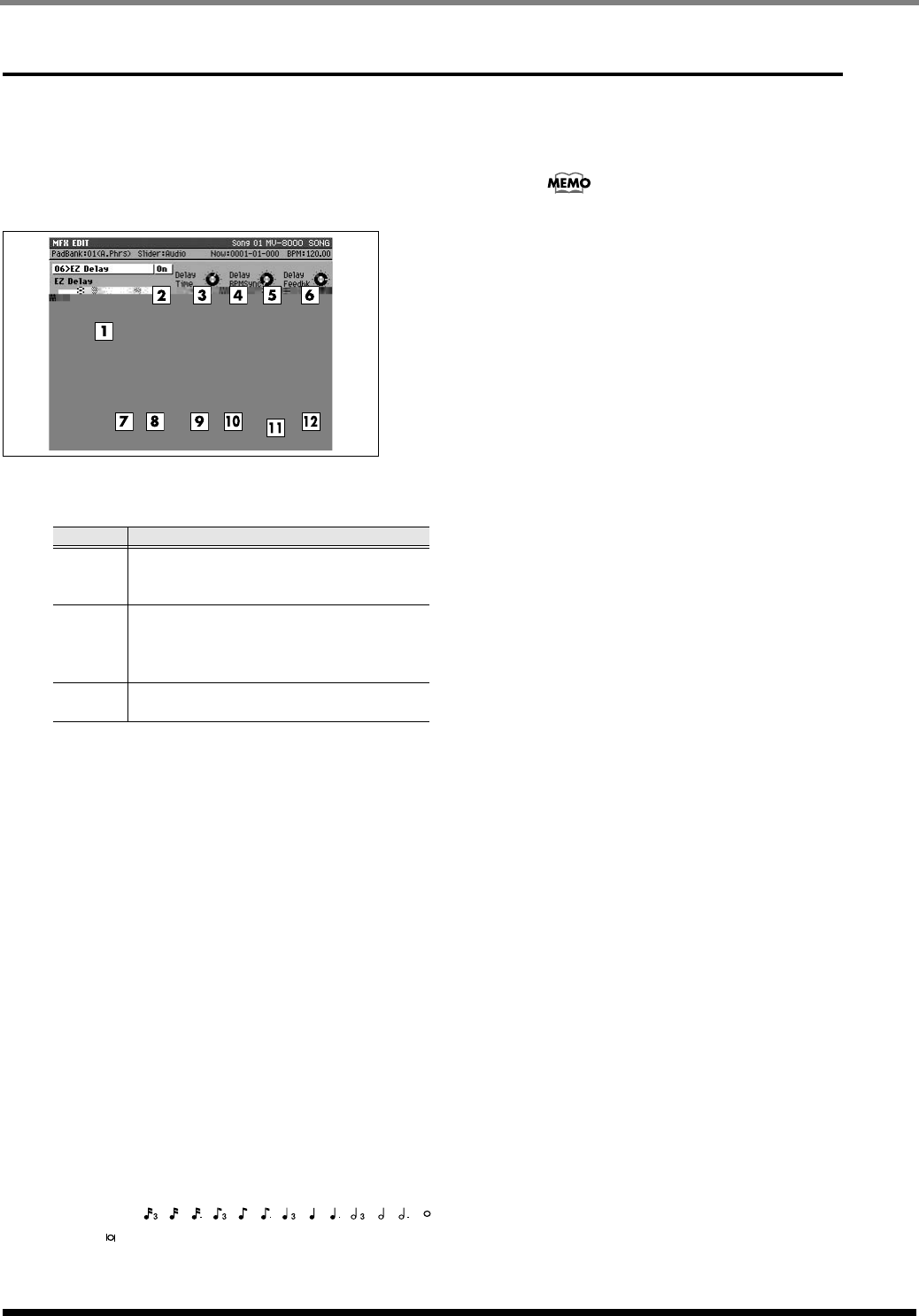
408
Effect Block
06 EZ DELAY
Delay (EZ Delay)
This digital delay can be switched between stereo,
mono, and alternate settings, and the delay time can
be synchronized with a song’s tempo. It features a
maximum delay of 1200 msec (1.2 seconds).
1.
Mode
This switches stereo, monaural, or alternate.
2.
Delay Time
Value: 1–1200 msec
Sets the delay time, that is, the elapsed time between
the source sound and the delay sound. When in
mono or stereo mode, the settings value is limited by
the left-right shift settings. In alternate mode, this is
limited to 0–600 msec.
When Tempo Sync (explained below) is active, this
setting is not effective, and you cannot make this
setting.
3.
L-R Shift
Value: L1199–R1199 msec
Of the delayed sounds on the left and right, the delay
time is increased on only one side, shifting expression
of the sound. Depending on the time setting, settings
values may be limited. This is disabled in alternate
mode, and you cannot make its setting.
4.
Tempo Sync
Value: OFF, , , , , , , , , , , , , ,
Set this when synchronizing the delay time to the
song tempo. When you select the note, the delay time
is set to match the length of the note. When not
synchronizing, turn this off.
If the set note length is longer (or shorter) than the
possible range of delay time settings, the delay time
can not correspond to the note length. If “?” appears
before the note symbol you set, it is because the
upper (or lower) limit of the setting range has been
exceeded, and that the synchronization is not
correct. Furthermore, the precision of the delay time
and song tempo differ. If left to develop over long
periods, the two may drift apart.
5.
L-R Order
Value: L>>R, L<<R
In alternate mode, this setting determines which of
the left or right sides has the delay sound before the
other (at L>>R, the left side is expressed first; when
set to L<<R, the right side is expressed first). This is
disabled in alternate mode, and you cannot make its
setting.
6.
Effect Level
Value: 0–100
Sets the volume of the delay sound. When use this
algorithm in insertion, lower it to get a balance with
the direct level.
7.
Low Damp Freq
Value: 50 Hz–4000 Hz
Sets the upper frequency limit of the range to be
damped by “Low Damp.” The Low Damp function
damps the low frequency band of the delay sound
quicker than other bands, which makes for a clearer
delay effect.
8.
Low Damp Gain
Value: -36 dB–0 dB
Sets the degree of the Low Damp.
9.
High Damp Freq
Value: 1 kHz–20 kHz
In the natural world, the high frequencies in echo die
out quicker than other bands. High Damp, by
attenuating the higher frequencies first, makes the
delay sound more natural.
Sets the lower frequency limit of the range to be
dampened.
10.
High Damp Gain
Value: 36 dB–0 dB
Sets the degree of the High Damp.
Value
Explanation
Mono
This is a single-input, dual-output de-
lay. Stereo sound (left and right) are
mixed before being input.
Stereo
This is a dual-input, dual-output delay.
The delay sound output features the
same stereo placement as that of the in-
put.
Alt
The left and right delay sound output
alternately.
ECS05_manual_e.book 408 ページ 2005年11月30日 水曜日 午前11時14分


















